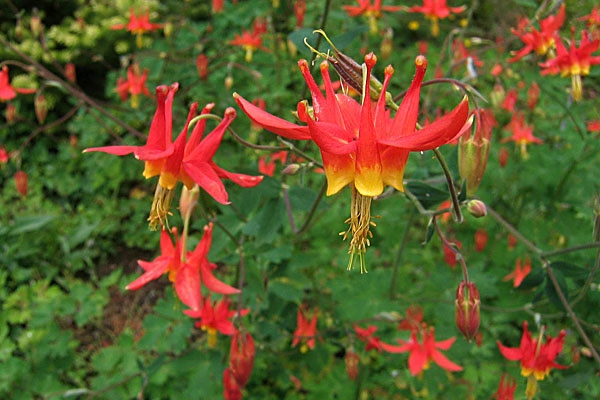
Columbine
Botanical Name
:
Aquilegia spp.
Plant Type
:
Herbaceous perennial
Seasons
:
Plant in early spring or fall; Blooms in spring and summer
Sun Level
:
Partial shade or full sun in cooler regions
Ideal Soil Temperature for Planting
:
70–85°F (21–29°C)
Soil Type
:
Sandy, loamy, moist but well-drained
Hardiness Zones
:
3–8 (USDA)
Germination
:
Seeds take 21–28 days to germinate
P.H. Level
:
Neutral to slightly acidic
Water/Irrigation
:
Maintain consistently moist soil (avoid sogginess) for young plants; water when the top 1–2 inches of soil become dry
Fertilization
:
Fertilize monthly throughout the growing period for optimal growth
Habit
:
Clumping and mounding
Propagation
:
Division, seeds
Final Plant Height
:
1–3 ft (30–90 cm)
Spread
:
1–2 ft (30–60 cm)
Flowers
:
Red, orange, yellow, blue, purple, violet, pink, white
Attracts
:
Hummingbirds, hawk moths, butterflies, and sweat bees
Uses
:
Ideal for cottage gardens and woodland settings; beautiful as cut flowers; works well in rock gardens and along borders
Companions
:
Hostas, Allium, daylilies, foxglove, heuchera, iris, and poppies
Pruning
:
Cut back to half of their height after flowering
Toxicity
:
Seeds and roots can be toxic to humans
Pests
:
Leafminers, sawflies, spider mites, fungus gnats, fruit flies, and mealybugs
Diseases
:
Flower and leaf blight, botrytis cinerea, and gray mold
Additional Info
:
Mulch around the base to retain soil moisture and regulate temperature
Botanical Name
:
Aquilegia spp.
Plant Type
:
Herbaceous perennial
Seasons
:
Plant in early spring or fall; Blooms in spring and summer
Sun Level
:
Partial shade or full sun in cooler regions
Ideal Soil Temperature for Planting
:
70–85°F (21–29°C)
Soil Type
:
Sandy, loamy, moist but well-drained
Hardiness Zones
:
3–8 (USDA)
Germination
:
Seeds take 21–28 days to germinate
P.H. Level
:
Neutral to slightly acidic
Water/Irrigation
:
Maintain consistently moist soil (avoid sogginess) for young plants; water when the top 1–2 inches of soil become dry
Fertilization
:
Fertilize monthly throughout the growing period for optimal growth
Habit
:
Clumping and mounding
Propagation
:
Division, seeds
Final Plant Height
:
1–3 ft (30–90 cm)
Spread
:
1–2 ft (30–60 cm)
Flowers
:
Red, orange, yellow, blue, purple, violet, pink, white
Attracts
:
Hummingbirds, hawk moths, butterflies, and sweat bees
Uses
:
Ideal for cottage gardens and woodland settings; beautiful as cut flowers; works well in rock gardens and along borders
Companions
:
Hostas, Allium, daylilies, foxglove, heuchera, iris, and poppies
Pruning
:
Cut back to half of their height after flowering
Toxicity
:
Seeds and roots can be toxic to humans
Pests
:
Leafminers, sawflies, spider mites, fungus gnats, fruit flies, and mealybugs
Diseases
:
Flower and leaf blight, botrytis cinerea, and gray mold
Additional Info
:
Mulch around the base to retain soil moisture and regulate temperature
Written by Nondiah Khalayi – https://www.linkedin.com/in/nondiah-khalayi/

